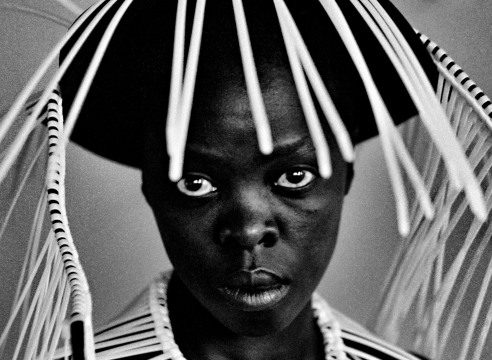Yancey Richardson Gallery, New York, presents Sawubona, a landmark exhibition by South African visual activist Zanele Muholi, featuring works from five series created between 2002 and 2013. More than a retrospective, Sawubona— meaning “I see you” in isiZulu — is a profound act of recognition and empowerment for the Black LGBTQIA+ community in South Africa and beyond.
This marks Muholi’s fifth exhibition with the gallery and their first outside of Africa to feature early works, offering a rare and intimate look into the artist’s formative years and foundational projects. Spanning more than two decades of activism through visual storytelling, this exhibition brings together portraits that are tender, defiant, complex, and above all, human.
A Visual Archive of Resistance and Celebration
Muholi’s approach to portraiture is not simply about capturing likeness — it’s about reclaiming narrative. Long before their internationally renowned self-portrait series Somnyama Ngonyama, they had already launched a body of work dedicated to dismantling stereotypes and queerphobic representations in South African society.
In projects like Only Half the Picture (2002–2006) and Being (2006), Muholi reimagines how Black queer bodies are seen — and more importantly, how they see themselves. These photographs center dignity, introspection, and intimacy, avoiding the exploitative lens often cast on marginalized identities. Rather than portray trauma in explicit form, Muholi’s early photographs highlight stillness, love, and survival through subtle gestures and fragmented compositions.
Reframing Masculinity, Beauty, and Belonging
In Beulahs (2006) and Miss Lesbian (2009), Muholi boldly explores the politics of gender performance and self-definition. Beulahs portrays queer men in public spaces, their fashion and posture breaking away from rigid ideas of masculinity. The term ‘beulah’ — colloquial in South Africa for a beautiful gay man — becomes a vehicle for celebrating fluidity, desire, and visibility.
Miss Lesbian, on the other hand, flips the spectacle of beauty pageants to critique societal standards. In these self-portraits, Muholi engages with the aesthetics of performance and display, showing how “acceptance” is often predicated on conformity to gender norms that erase queer experience. With each crown and sash, Muholi asks: who gets to be seen, and under what conditions?
Faces and Phases: A Living Archive
Perhaps the most ambitious and ongoing of Muholi’s projects, Faces and Phases (2006–ongoing) is both commemorative and historical — an evolving community portrait made up of Black LGBTQIA+ individuals across South Africa. Many of the subjects have been photographed over time, making the work an emotional and visual map of growth, transition, and resilience.
Each image in Faces and Phases is a document of presence. A refusal to be erased. A reminder that Black queer lives are not footnotes in history — they are history in motion.
A Collaborative Vision
What sets Muholi apart is their collaborative, participant-centered process. They refer to those they photograph not as “subjects,” but as participants — a term that recognizes shared agency, consent, and co-authorship in the act of image-making.
This ethos of mutual respect and representation underpins Sawubona. To say “I see you” is not just an acknowledgment of presence — it’s an affirmation of worth. In a world that so often invisibilizes queer Black bodies, Muholi’s work is a mirror, a stage, a sanctuary.
A Necessary Invitation
Sawubona is more than an exhibition — it’s a gesture of witnessing and solidarity. At a time when LGBTQIA+ communities continue to face violence and marginalization across the globe, Zanele Muholi offers a counter-narrative rooted in visibility, care, and joy.
To walk through this exhibition is to encounter stories that are political yet deeply personal, radically tender, and unapologetically powerful. It is an urgent reminder that representation matters — especially when it’s created from within.
“Sawubona” is on view now at Yancey Richardson Gallery. Step into the archive. Be seen — and see others fully. Because in the words of Muholi: “We express our gendered, racialized and classified selves in rich and diverse ways.”
